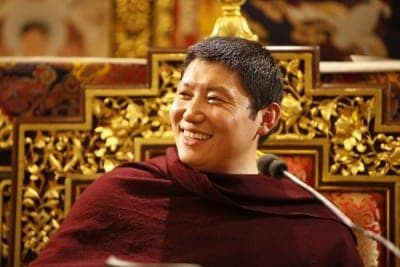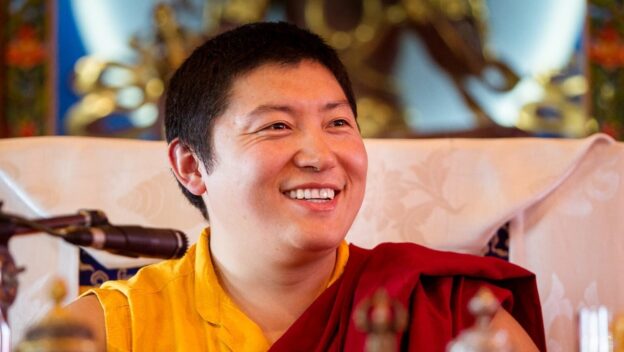Languages
Path of Meditation Level One is available in the following languages:
- English
- 简体中文
- Português
- Español
- Tiếng Việt
About This Course
We warmly invite you to The Path of Meditation Home Practice Program. This path is suitable for both absolute beginners and for those who wish to rededicate themselves to meditation practice. This program does not presuppose any background in Buddhist practice or meditation. We encourage all those with sincere interest to take advantage of this structured approach. Here, Phakchok Rinpoche guides us gradually through an experiential practice of the path.
Meditation Benefits Us in Two Ways
- First, on the relative level, meditation helps us develop a balanced and healthy life.
- And ultimately, we connect with our own basic goodness, our awakened Buddha nature.
What Is the Path of Meditation and Mahamudra?
Buddhist teachings include 84,000 varieties. These include the foundational Theravada traditions, the Mahayana sutra traditions, and the Vajrayana lineages. And all of these teach a variety of meditation techniques. In this program, Phakchok Rinpoche encourages students to take up the practice of Mahamudra meditation.
And why should we do that? In a recent teaching, Rinpoche observed:
Maha means great mind. Mudra means all-pervasive. When we are first learning meditation, it is important to know two things. First, the mind is the base of happiness and suffering. Our mind is not reliable as as a source of calmness. It always changes… The most important thing to understand is that when the mind is calm, the mind is happy. When the mind is not calm, the mind is not happy… These differences are very important things for the meditator to know. Not just knowing in the mind (intellectually), but having the experience.
The second thing is the nature of the mind. When you recognize the nature of the mind, it is very peaceful. In that moment of recognition, you are the happiest person. It’s very strange to say that, but that’s how it is… When you recognize nature of mind…that is called seeing or recognizing, or having a short glimpse of Buddha.
Here, in the following video clip, Rinpoche explains why he sees value in teaching the Mahamudra path of gradual progress. As Rinpoche explains, he usually teaches students this path over a period of three to five years.
We can reflect on the following advantages:
- students take time to develop understanding and experience
- we gain glimpses of realization that prepare us for other practices
- we spend time on knowing our minds and practicing
- this path requires less time in study–the focus is meditation
What Is Meditation?
Meditation is not only about sitting on a cushion. In the video clip below, Rinpoche reminds us that meditation is holistic. Throughout this program, we will practice integrating the insights from meditation in all aspects of our life.
What Are the Benefits of Meditation?
As modern people, we are very busy and have so many options. So, why should we meditate? And does meditation really benefit me and my loved ones?
In this video clip, Rinpoche explains that meditation helps us to grow in an intelligent way. Moreover, he mentions the following benefits of practice:
- calmness and peacefulness
- a more relaxed, natural and loose approach to life
- space to see what is going on in our mind and emotional states
- happier mind-set
- less stress–more able to handle problems
- reduced ego-clinging
- less hope and fear
- transformation–real change in our way of being
- gaining realization of emptiness
- ultimate awakening/enlightenment
About Phakchok Rinpoche
Phakchok Rinpoche was born in 1981. He holds the lineage of the Profound Treasures of Chokgyur Lingpa. This lineage is part of the Nyingma School of Early Translations. Moreover, Rinpoche is one of the throne-holders of the Riwoche Taklung Kagyu Lineage. Phakchok Rinpoche’s primary root gurus are his grandfather, the late Kyabje Tulku Urgyen Rinpoche, and the late Kyabje Nyoshul Khen Rinpoche.

Rinpoche received a traditional education and a Khenpo degree from the Dzongsar Shedra in India. He also received the complete Chokling New Treasures lineage transmission from Tulku Urgyen Rinpoche and Kyabje Tsikey Chokling Rinpoche. Finally, he received the Great Perfection lineage from Nyoshul Khen Rinpoche.
Teaching Style
Rinpoche addresses the needs of his audience using a very direct teaching style. He presents the authentic Dharma, respecting the transmission of the lineage and past masters. At the same time, he expresses authentic teachings in simple language. He interweaves modern examples with traditional training. Therefore people with diverse backgrounds and interests easily relate to and appreciate his teachings. In this home practice program, Rinpoche teaches in English.
Rinpoche speaks directly to the concerns of modern students. He often uses humor and personal stories to touch our hearts. Additionally, Rinpoche has traveled widely and taught to people from different backgrounds. And, he conducts many question and answer sessions with students during his travels. Therefore, he understands problems and issues facing students today. Moreover, he accepts that students have busy lives and many demands. Thus, in this course he often gives short practice tips designed for busy people.
Balance in Life
Rinpoche is a yogi practitioner with both a family and the responsibility of monastic institutions. Thus, he is deeply familiar with multiple demands. His own life defines what it means to be a dharma practitioner in today’s world. Therefore he regularly emphasizes that all practitioners need to cultivate balance in their lives.
Principles of Practice
We progress best when we build a base of study and contemplation. With this foundation, we can understand the profound views of the Buddha’s teachings. Next, we also must do the practice. Then we can begin to genuinely reduce ego clinging. Also, we learn how to transform our negative emotions. In this process, we use a wide range of methods and practices.
Further, we address the needs of our families, communities and the larger world by participating in altruistic activity. This activity arises as the expression of the compassion and wisdom cultivated in practice. These are some of the main principles that Rinpoche practices and teaches to his own students.
The Path of Meditation Home Practice Program presents classic, authentic instructions in short, clear modules. In this way, students may properly reflect on the message of the instructions. Most importantly, students learn exactly what to practice. In this way, we develop confidence in our ability to gain experience and realization.
Curriculum
Phakchok Rinpoche designed the Path Of Meditation Practice Chart that outlines the entire path. Here, in a clear visual one-page map, we can see the gradual and natural unfolding of practice.
The major stages of the path evolve as follows:
- First, we begin meditation training by practicing calm abiding meditation.
- Next, we progress step-by-step to clear seeing, or insight, meditation.
- Finally, we begin the main practice: supreme clear seeing
This home practice program follows the practice chart. We offer both video and audio teachings. In these, Rinpoche instructs us on the important themes of the Buddha’s teachings. And most importantly, he focuses on practice instruction in meditation itself. Throughout the process, we also provide reflection exercises and contemplation questions to help you process the material you are studying.
Translations
About Instructor



